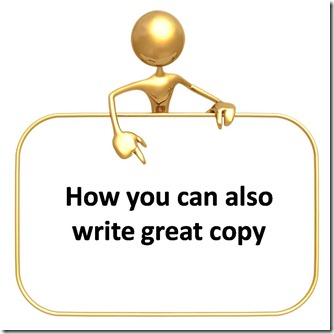Entries from June 2010 ↓
June 18th, 2010 — copywriter, freelance copywriter, marketing

Copywriter
There are a number of people out there that believe marketing copywriting is all about hype.
You will obviously emphasize the main benefits your product/service will bring to your customers, but not in a way to sound unbelievable.
Your readers aren’t stupid and they’ll soon pick up on unrealistic claims. And when they do, they’ll simply move on to another business that has a more honest approach.
There is also another brand of copywriting out there.
Does my bum look big in this?
That is a prime example of a question you should answer with conviction. A resounding “absolutely not” is far more convincing than “I don’t think so”.
In a similar vein, there is rather a lot of copy out there which sounds very uncertain. You can spot it a mile off as it contains words like:
- perhaps
- like
- maybe
- sometimes
- generally
- on the whole
By using these words in your copy you are shouting from the roof tops “I’m not really sure whether you would be interested or not in our products but perhaps you might like to try it – if you wanted to – possibly?”
You’ll come across as though you are either:
a) hiding something from you reader
b) not at all convinced about your product/service
You know your product/service better than anyone. Your writing has to be positive and convincing. If you want to show your reader you mean business and that your product is perfect for them, you must use words such as:
- guaranteed
- proven results
- best
- always
I’m sure you can think of many others.
Why you need to know this
We are not always good at shouting about how great our businesses are. But in your marketing, there’s no room for empty platitudes.
By using strong, commanding language within your marketing you are showing your confidence in your product. Your confidence will instil confidence in your reader – just make sure you don’t make empty promises. You must be sincere, honest and trustworthy if you are to attract and retain clients.
Sally Ormond – freelance copywriter
June 16th, 2010 — copywriter, freelance copywriter, social media, social media marketing

Social media marketing has revolutionised the way businesses interact with their customers.
In the good old days, new clients were found through cold calling, leaflet drops and word of mouth.
Today, you can use Twitter, blogs, Facebook, Google Wave and all manner of Web 2 properties to engage with your audience and win new customers. But all that social media activity can take over your time if you let it.
One of the biggest reasons some businesses don’t use social media is time. Granted, if you’re not organised you can waste an inordinate amount of time Tweeting and blogging. But, if you are disciplined, you can gain great results.
Make social media work for you
If you want to get the best out of social media, you must be strict with yourself and follow these simple rules.
1. It’s not your full time job
It is true that for social media to be effective you must do it regularly. This is because it is all about building relationships with people. The more you talk and engage with them, the more they will grow to trust you. But, never lose sight of the fact that this isn’t your full time job.
Social media is an enhancement to your marketing arsenal. Build it into your weekly work schedule and set aside a specific time for it. Getting into a routine like that will help you keep it under control.
2. Set a time limit
The most addictive and time consuming of all social media is Twitter. It is very easy to trawl through your followers’ tweets – and once you get engrossed in the stream, you may never find your way out again.
If you are going to tweet, make sure you specify a certain amount of time to it and don’t go over it. You can also automate tweets or funnel your blog RSS feed into your Twitter account so you are contributing to the Twitter world without actually being there.
3. Set goals
If you are going to utilise social media as a marketing tool, you must ensure you have specific goals in mind. If you know what you want to get out of it, you’re more likely to achieve results and you will be more likely to use it in a constructive way.
Every blog post and article that you write should have a purpose. They will be used to attract a certain audience, increase traffic to your website or boost your exposure as an expert in your field.
4. Prioritise
The key thing to remember is that your social media activities are secondary. Your primary aims should be your daily work. Therefore as a freelance copywriter my primary aim is to complete the website copywriting project,, brochure, case study or email for my client. Social media is my secondary objective so only when my primary goals have been completed do I make time for blogging, article writing and Twitter.
When using social media marketing always keep an eye on your results. Much of what you do will be measurable so make sure you check the effectiveness of all that you do.
The main thing is that you enjoy social media – it’s about engaging with people, talking to them and sharing information. It is the perfect way to display the human side of your business.
June 14th, 2010 — copywriter, freelance copywriter, newsletter

Sending out a regular newsletter is a great way to market to your customers.
But not only that, they also offer a vital link between you and your customers. Regular content that adds value, will keep your customers loyal.
But how to do you go about increasing the number of newsletter subscribers you have? Well, here are a few suggestions to help you.
1. Show them
Signing up to a newsletter is often an unknown quantity for many people. They are handing over their email address to a complete stranger so to make the process less painful, show them what they’re going to get.
Set up a sample newsletter that they can click through to from your website. Of course, if you do this you will then have to ensure that all future editions of your newsletter are similar.
2. If all else fails, bribe
Bribery is perfectly acceptable. Make it worth their while. Offer them something for free – eBook, report, discount – whatever it is, it must be something of value.
3. Timing
When you ask for a sign up is very important. If you sell through your website, the prime opportunity is when they have just bought something from you.
Make good use of your ‘Thank you for ordering’ screen and make sure your opt-in box is in a prominent place. If you often incorporate offers in your newsletters tell them, if they’ve bought from you once, the chances are they will again.
4. Segmentation
If you offer a range of products or services, it would be best to offer different newsletters for different sections of your business. After all, not everyone is going to be interested in everything you sell. Plus if the content of the newsletter is tailored to their specific interests, they more likely to remain subscribed.
5. Pretty
Don’t just bang out any old newsletter. Make sure it is easy on the eye and looks professional. Also, before sending, check it in all email browsers. The last thing you want is for some recipients to receive a ‘broken’ email.
6. Great content
This is really the key to retaining your subscribers. Make sure every issue is packed with interesting and relevant copy that will reflect your readers’ interests.
7. Second chance
Even if you follow tips 1 to 6, you will still get some people unsubscribe. Firstly, don’t take it personally. Secondly, this is a great chance to convince them to stay.
When they get through to your unsubscribe page, offer them a change of frequency or ask them to select a more specific newsletter from your segmented list.
Are you a regular user of newsletters? If so, how do you make sure you keep your readers interested?
Sally Ormond – freelance copywriter
June 11th, 2010 — copywriter, freelance copywriter, marketing, Press releases

One of the best marketing tools any business can use is the press release.
But it is possibly one of the most under utilised forms of marketing.
The main reason for this, is that businesses often think they don’t have anything newsworthy to shout about. But there are a number of opportunities where you can issue a press release.
Sending out regular press releases is a great way to keep your business’s name ‘out there’ in the marketing place. No only that, but by publishing them online, you will be generating those all important one way back links to your website that are so important for search engine optimisation.
So when should you issue a press release? Well, whenever you do something new. To help you out, I have compiled this list of press release opportunities that shouldn’t be missed.
10 Reasons to send a press release
1. New product
This is probably the most obvious. When you launch a new product or service, make sure you send out a press release. It is the ideal opportunity to announce to the world what you are doing.
Always make sure you provide a link back to your website so your readers can easily get to your site for further information.
2. Case study/Survey
If you have recently carried out a survey or case study, make sure you issue a press release to announce the results.
This type of information will be very interesting to people in your industry or who have an interest in it.
3. Current events
If current news events are relevant to your business, press release about it. Topical issues are always of great interest so use what’s in the news to spread the word about your company.
4. Industry trends
You will be keeping an eye on what’s happening in your industry so make sure you use press releases to comment on the latest trends. Whether you want to highlight how trends are effecting business or how you have changed processes as a result of new trends, this type of industry comment will help bolster your position as an expert in your field.
5. Congratulations!
If your business has received an award or commendation, press release it. Blowing your own trumpet is an opportunity you can’t miss. It shows readers you are very good at what you do.
6. Growth
Have you taken on new staff? Moved to new premises? Bought a new fleet of vans? Any signs of growth are worth shouting about, especially in today’s climate.
7. Charity
Whether your company has donated to a charity, or if you are taking part in a charity event, this again is a prime opportunity for a press release. It will show your company as one that is involved with the community.
8. Freebies
Are you about to give away a free eBook, report or white paper? Don’t leave people to find out about it by chance, make sure you issue a press release about it.
9. The weird and wonderful
Press releases don’t just have to be about company milestones. If something bizarre has happened recently, write about it. Human interest stories are always popular. Share your experiences.
10. Employees
Have some of your employees done anything newsworthy? Whether it is being involved in a charity event or an inspirational tale of overcoming adversity, people love to read about other people.
At the end of the day, press releases will help you strengthen your place in the market and show your company as one that can be trusted. By issuing regular releases you will keep your company name in the forefront of your customer’s minds.
Don’t let the opportunity pass you by – press release it!
Sally Ormond – freelance copywriter
June 9th, 2010 — copywriter, copywriting, freelance copywriter, marketing

A strange thing for a freelance copywriter to write about? Well, yes and no.
One question I often get asked is why do I think I can write better copy than someone who’s involved in the business and knows it inside and out.
Well, there’s the answer. Yes, you know your business better than anyone else. But because you know it so well, you become totally absorbed by it. How often have you been asked what you do by someone? And by the time you’ve finished explaining they’ve dozed off, lost interest or are completely confused?
You see, there lies the problem. It is very difficult to take a step back from your business to see it from someone else’s point of view. If you are writing your own marketing materials, you have to write for your reader. You have to get into their shoes and explain exactly what benefits your product or service will bring to their lives – which isn’t easy.
But there’s more to it than that. Writing to attract and engage readers isn’t as easy as it sounds. Below are a few pointers to show how you can improve your writing, and turn it into great sales copy:
Think about your reader
Many businesses, when they write their own copy, don’t have their reader in mind. They tend to write content that they would want to read, which is usually very different from what their customers want.
Think about your readers – what type of people are they? What age are they? What are they interested in? Only when you have looked into this can you decide what tone to take. Should the voice you use be casual, formal, conversational?
If you are writing to a teenage audience, you’re likely to take a different approach to an audience who are 40+. They will have different priorities and interests so your copy must reflect that.
Grammar
We all hated it at school, but it’s a vital part of getting your message across. You will be judged on your use of the English language. Therefore you must ensure you follow the grammatical rules (although they can be bent at times to achieve certain effects). Spelling is also key – make sure everything you publish has been proofread. There is nothing more off putting than reading something full of spelling and punctuation errors.
Your writing will say a lot about your company – sloppy use of grammar, spelling and punctuation will suggest your business is one that doesn’t care about attention to detail!
Headlines
The headlines you use in your communications will determine whether or not they get read. It sounds harsh, but most people judge content by the heading.
A weak and uninspiring heading won’t encourage your audience to continue reading. Therefore it really is worth spending a lot of time coming up with the perfect headline.
Make it simple
One trap that many business owners fall into when it comes to writing their own copy, is that they write it in jargon.
Your readers are only interested in one thing, and that’s what you are going to do for them. If you write copy that is centred on your business, how great it is, and full of jargon, your reader will be switched off in an instant.
Target your reader in everything you write. Make sure you show the benefits of your product and service to them.
But above all, make sure you use simple sentences and words. Many business people have a hang up about using an impressively large vocabulary when writing. That is one of the biggest turn offs ever. No matter how educated your audience, keep your words and sentence structure simple. People lead very busy lives these days so they want to be able to read quickly. Therefore the layout of your communication is also important – make sure the benefits stand out by placing them in bold type or in a bulleted list.
Why am I telling you this?
All your written communications (website copy, email marketing, newsletters, case studies, press releases etc.) reflect your business. Therefore it is vital you get them right.
Most people don’t consider hiring a copywriter because they think they can do it themselves. But let me ask you something, you can probably lay a few bricks if you tried hard enough, but would you consider building an entire house on your own? Probably not.
When your business relies so heavily on your written communications, it really is worth thinking about bringing in the professionals – after all you don’t want all your years of hard work to come tumbling down.










